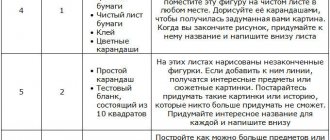Greetings, friends!
Thinking is a multifaceted process for which there are a large number of different definitions in psychology. In general, this term refers to the process of mental processing of information based on a person’s accumulated knowledge and axiomatic ideas about the world around him. In the process of mental activity, a person analyzes incoming information, draws conclusions, expands and complements his picture of the world.
Each of us is interested in developing and improving our thinking skills. They allow us to analyze the situation more accurately and quickly, draw the right conclusions and make the right decisions. To understand how to develop thinking, you must first find out what it is, how it is structured, how it works and what it depends on. Today we will examine these issues in detail, after which we will consider several effective exercises.
What is thinking?
Thinking is what makes us human. It is the ability to think analytically, compare facts and expand our picture of the world through logical conclusions that distinguishes us from animals. There are several types of thinking that differ in how a person analyzes information and draws conclusions. The most common types of thinking are:
- analytical – the ability to analyze a large number of facts, find complex relationships between various phenomena;
- logical – the ability to correctly compare facts, determine their significance and reliability, and make correct conclusions;
- deductive - the ability to draw the right conclusions in a specific situation, based on general knowledge (the principle of “from general to specific”);
- inductive – the ability to draw correct general conclusions based on a particular case (the principle “from the particular to the general”);
- systemic - a special approach to understanding the world around us, aimed at organizing and optimizing available knowledge;
- creative is a special type of thinking that allows you to generate new ideas, find non-standard solutions, and make discoveries.
All types of thinking can work with varying degrees of effectiveness. The good news is that they can be developed, the main thing is to know how to do it. But before moving on to specific exercises, let’s take a closer look at how thought processes work.
Visual-figurative thinking training
Visual-figurative thinking operates with images, involving the mechanism of spatial imagination in the process of cognition of the surrounding reality.
Creating an image of a specific event
You should remember a family event, such as a birthday. They reproduce a real picture in their memory, noting how many people there were, how they sat at the table, and what they were wearing. You need to remember the toasts made, the topics of conversation, what dishes were served, their taste.
Description from memory
On a piece of paper, describe in detail the image of a sunset, drops of dew, a soaring swallow, imagining them mentally in your memory.
How does thinking work?
Every thought that exists in our minds represents an associative connection between several images and concepts. Individual images that appear in our thoughts seem to pull invisible strings, forcing us to remember other concepts associated with them. As a result, a kind of cause-and-effect relationship arises, provoking an endless process of replacing some concepts and images with others.
By studying how the thought process works, scientists found that it consists of several key components:
- Analysis
. Dividing a complex essence into simplest images. - Synthesis
. Combining the simplest components interconnected into complex objects and phenomena. - Comparison
. Comparison of individual entities, search for similarities and differences. - Classification
. Distribution of objects into categories based on the presence of certain characteristics. - Abstraction
. Isolating the most important features while ignoring other characteristics. - Generalization
. Grouping of disparate objects based on the presence of similar characteristics. - Concretization
. Identification of one object with clarification of its distinctive characteristics.
All these processes serve one purpose - to help us make the right decisions based on the available data. As a result of cognitive and mental activity, complex connections are formed in our minds between various images, from which the overall picture of the world is formed. And the decision made in each specific situation is the result of processing all the information we have ever received.
Speech structure
From the point of view of effective thinking, speech consists of two main parts.
- The main course is a chain of statements that contains the main meaning.
- Side dish - additional information that does not change the main meaning in any way, serves to captivate the audience and create the context of the “story”. In general, what is now called storytelling.
Very often speech looks like a huge station pie. It's big on the outside, but when you start eating it, you find that it takes quite a while to get to the filling.
After understanding this structure, it is important to separate the two types of perception. And consciously make a choice which perception to include now, and what the result will be after that.
The first type of perception is that we eat a side dish mixed with the main dish and enjoy the taste.
Pros - it is easier to immerse yourself in history, receive sensual - emotional pleasure. Cons - a skillful speaker will easily lead you to any conclusions. Well, if the content is completely truthful, then the quality of its development and understanding will be much worse. Don't rush to object. Try to apply, compare and see for yourself.
The second type of perception is that we strictly cut off the side dish and conduct a strict analysis of the main dish.
Pros - understanding becomes as great as possible. There is a clear understanding of what questions need to be asked in order to make the picture as clear as possible. It is these questions that will easily expose a charlatan in one case, or will give the impression of sincere interest to a good specialist in another.
After the work done, the reward will be a feeling of satisfaction.
Cons: You won’t be able to immerse yourself in the story and relax. If the subject of the conversation is complex, then you can get seriously tired.
How to develop thinking?
In order to develop your thinking, you need to systematically work through each of the components listed above, improving in such areas as:
- critical thinking (the ability to analyze a situation, breaking it down into individual facts, comparing and contrasting them, determining their plausibility and reliability);
- ability to synthesize (the ability to combine a large number of facts into one complex entity, object or process);
- the ability to compare events and facts, finding significant differences and similarities;
- ability to classify (an important skill necessary for remembering new information);
- abstraction (highlighting key characteristics and discarding irrelevant ones);
- the ability to generalize (collect disparate objects into groups, combining them according to common characteristics);
- the ability to specify (concentrate attention on a specific image).
By developing in all of these directions, you can significantly improve the quality of tactical and strategic thinking, which will allow you to better plan your actions on the way to your goal in the future. There are a wide variety of exercises for this. We will look at 10 of them, which do not require special skills or special tools - just your desire and determination.
We are building a mental machine.
The construction itself is as follows:
- We construct the first statement (verbally, cutting off the unnecessary).
- In the statement, we check both the essence and the action for payback. If there is no payback, we ask questions and look for answers.
- We hold entities and actions in the imagination in the form of images.
- Let's add the following statement.
- We are looking for with the help of what action or entity the second statement is linked to the first. Sometimes this is stated explicitly, sometimes it is not stated at all. If it is not indicated, but is, as it were, “implied,” then one must make the implied statement a new statement and explicitly turn the gears that make it up.
- Making the second statement pay off.
- We add the essence and action of the second statement in the form of images to the picture.
- We are trying to twist/change the resulting coupling.
- Repeat steps 4-8 for each new statement.
As a result, in our imagination we will have a model, each element that we understand thoroughly. This means that the model turns into a single mechanism, which, in turn, we can change as we want or use it as a tool anywhere.
It looks cumbersome, but in reality many steps can be done very quickly. And after you get the hang of it, you can almost instantly distinguish payable entities/actions from non-payoff ones.
Main mistakes:
“They wasted a lot of time memorizing things like that when they could have been found and viewed in fifteen minutes.” Richard Feynman.
- Skip any entities/actions because they seem obvious to you. They may be obvious in other contexts. But it is not a fact that this will be obvious. Also, their influence/coupling with neighboring entities/actions may not be very obvious.
- To be lazy about twisting/twirling entities and actions. Understanding is never built through memorization. Only through interaction with entities and actions.
Exercises for developing thinking
Reading
This is a simple and at the same time effective way to develop thinking. While reading, we intently analyze the flow of incoming information. It is useful to read both educational literature and fiction. In the first case, you can broaden your horizons, and in the second, you can gain valuable experience by thinking about and analyzing the actions of the main characters of a literary work. Reading gives new knowledge, increases the level of intelligence, develops memory and helps in self-development.
Why is all this needed?
Firstly, we can hold a limited number of thoughts and ideas in our heads. And if you try to perceive everything , you will lose the main thing.
Secondly, we will need to work with statements. The simpler the statements, the easier and faster it is to work with them. The faster we work with them, the more operations we can do per unit of time. The more operations there are, the better we understand the model built in our heads (the chain of key statements).
Training
The most effective way to develop thinking in a short time is to undergo training. I present to your attention the course “Development of Thinking” from Vikium.
You will learn:
- make the right decisions with lightning speed;
- clearly argue in disputes and convince;
- construct your speech competently and logically;
- count complex examples in your head with ease.
The course includes:
- thinking development program;
- theoretical video lectures;
- practical exercises and assignments
- simulators for the development of logic
This course will help:
- improve and speed up thinking;
- develop analytical skills;
- think critically in any situation;
- make unconventional decisions.
We make it worthwhile.
Payback is the ability to make accurate forecasts. A forecast is the answer to the question: “What will happen if you do this?”
Payback is possible only if we understand the essence of the phenomenon. And here we come across the main trap and at the same time a wild boost to thinking productivity. First I will formulate it, then I will explain it with examples.
Trap: very often understanding the essence is replaced by understanding the words.
Implications: Understanding words does not allow for accurate predictions.
An example of payback and accurate forecasts. There is a suggestion:
There is a wooden cube on the floor.
We have an entity - a small wooden cube. We begin to twist/twist. The cube has a property - position in space. If we change this property, we get the following questions:
“What happens if the cube is placed on the floor on one of its faces?”
“What happens if the cube is placed on the floor on its edge?”
Obviously, we can answer these questions accurately. In the first case, the cube will not move at all. In the second, the cube will fall on one of the faces and then stop moving.
An example of understanding words without understanding the meaning. There is a suggestion:
A note is a graphic designation of sound.
There is an essence - a note. It would seem that everything is clear. Since a note is a sound, a note has the same properties as a sound, such as pitch. We change this property and get the questions:
“And if the sound is made higher/lower by a few hertz, will it still be a note?
“Is every sound a note?”
“If not every sound is a note, then what distinguishes a note from a non-note?”
“How many notes are there?”
“Why so many?”
If you can answer these questions, congratulations, you have a real understanding of the essence of “note.” If not, then that's okay too. Most people mistake understanding words for understanding meaning. Indeed, from the point of view of understanding words, the sentence about the note is absolutely clear, not a single unfamiliar word.
That is, we take an entity and begin to change its properties. Twist and turn this way and that. If we understand what will happen, then we understand the essence well. If we don’t understand, then understanding is replaced by the feeling that the word is familiar to us.
Logical tasks for “stretching”
Problem 11
The father decided to ask his schoolboy son a tricky question: name the largest number. The son's answer stunned the father; there was nothing to object to.
This is an easy task for a programmer, right? But what did the schoolboy say?
Answer
Thirty-first. The date of the month is assumed.
Problem 12
A warlike tribe captured the wanderer. The leader wanted the wanderer to die and allowed him to choose. The wanderer was allowed to voice one phrase. If the phrase is true, he will be thrown from a steep cliff. If the phrase turns out to be false, he will be given over to the lions to be torn to pieces. But the wanderer chose a phrase that gave him freedom.
Guess what this phrase is?
Answer
Phrase: “I will be torn to pieces by lions.” Then, if the leader had given the wanderer to the lions to be torn to pieces, then the spoken phrase would have become true, and he would have been thrown from a steep cliff. But if the wanderer is thrown from a cliff, then the phrase will turn out to be false. The leader considered that the only correct outcome would be to give freedom to the wanderer.
Problem 13
After the party, the man was heading home, slightly tipsy. He walked along the center of a sandy country road. The path was not illuminated by moonlight. In addition, there were no lights on the road. The man's clothes were black. Suddenly a car pulled out onto the road with its headlights off. Eventually, the driver noticed the man and swerved.
How did he manage to see the pedestrian?
Answer
It was day outside.
Useful developmental exercises
Exercises to develop thinking do not take much time, some of them can be done on the way to work. You can alternate techniques for creative and logical development.
Yellow color in psychology - what it means for a woman, man, child
Training on the rapid development of abstract and creative thinking for adults and children:
- During the day, you need to pay attention to advertising signs, announcements, posters that contain photos or pictures. For each of them you need to come up with 2-3 descriptions: why this color, what the people in the photo are doing, what they will do next. It is necessary to be attentive and note every detail;
- Paradoxical answers. Understandable things need to be given an unusual explanation. For example, as a child, someone thought that trees sway and create wind, and not vice versa. It is necessary to find a few obvious phenomena and make a new interpretation;
- Game "yes and no". Two people participate, who must alternately make a wish for something (a film, a picture, a dish), the second must ask leading questions that can only be answered “yes” or “no”;
- Drawing upside down. You need to select any picture, turn it over and copy it. It is important not to overthink it, copy lines and shapes intuitively;
- Write a story. You need to choose a few words on which to write a story. The game helps improve intelligence.
Note! Creative thinking is developed by any type of arts and crafts and handmade work: drawing, knitting, modeling.
Brushes and paints
Effective exercises for developing logical thinking:
- Determine without scales how much a blanket, vase, chair, etc. weighs approximately. You can determine the distance, height, size of the cabinet. This method forces the brain to concentrate;
- Assembling a mosaic. Adults and children can take part;
- “Coding” is a game for 2 or more people. You need to choose a famous song or work and describe the plot without naming the main characters. The more complex and confusing the description, the better;
- You need to choose any word and mentally read it backwards;
- Crossword puzzles, puzzles and board games will help you train your logic. Riddles are suitable for children.
Note! The development of logic is facilitated by playing chess, checkers, solving examples and problems, as well as reading detective stories.
Game of chess
How to develop thinking in an adult in everyday life:
- Perform unfamiliar actions. You can cook a dish according to an unfamiliar recipe, learn a poem in a foreign language;
- Write or draw with your left hand. Left-handers try to write with their right hand;
- With your eyes closed, identify objects and their texture;
- Walk through the rooms with your eyes closed. This technique develops coordination and intuition;
- Eat with your eyes closed, discern the tastes and smells of food;
- Drive home from work along a different road, choose a short or long route.
How to identify poor development
The level of development of people of the same age may differ. Some people tend to analyze and think deeply, while others think superficially.
Signs of underdevelopment in an adult:
- Difficulties in completing tasks at work when colleagues cope without difficulty;
- It is difficult to formulate thoughts, construct speech correctly, frequent use of filler words;
- Mistakes are often made when writing words and sentences;
- Tension and migraines during decision making;
- Inability to logically distribute your tasks. It's hard to plan a route for the day;
- It is difficult to understand the meaning of what is read or said.
It's hard for a girl to think
The student is underdeveloped if:
- He doesn't read well;
- He cannot retell the meaning of what he read or heard;
- His speech is unrelated in meaning, he cannot formulate a thought;
- He has a bad memory;
- He can’t count, doesn’t know simple things: colors, names of objects.
Note! The child may have speech defects that are not related to mental development. Only a speech therapist can identify speech abnormalities, give recommendations and determine treatment methods.
Well-developed thinking is necessary for both a programmer and a private entrepreneur. A schoolchild and student will not be able to succeed in their studies without the ability to reason, draw conclusions and absorb information. Regardless of age, position and social status, your brain needs to be regularly trained and fully developed.
Logic is the science of conceptual thinking.
Logic, as a science of thinking, was born more than 2 thousand years ago in Ancient Greece. At the same time, the main types of logical thinking were described and the laws of logic were formulated, which remain unshakable to this day.
Two types of thinking: deduction and induction
The elementary unit of abstract-logical thinking is the concept. Several concepts combined into a coherent thought is a judgment. They are affirmative and negative. For example:
- “In autumn, the leaves fly off the trees” - affirmative.
- “There are no leaves on the trees in winter” – negative.
Judgments can also be true or false. Thus, the proposition “In winter, young leaves grow on trees” is false.
From two or more judgments one can draw a conclusion or inference, and this whole construction is called a syllogism. For example:
- 1st premise (judgment): “In autumn, leaves fall from the trees.”
- 2nd premise (judgment): “Now the leaves have begun to fly off the trees.”
- Conclusion (syllogism): “Autumn has come.”
Depending on the method on the basis of which the inference is made, there are two types of thinking: deductive and inductive.
Induction method. From several particular judgments a general conclusion is drawn. For example: “schoolboy Vasya doesn’t study in the summer,” “schoolboy Petya doesn’t study in the summer,” “schoolgirls Masha and Olya don’t study in the summer either.” Consequently, “schoolchildren do not study in the summer.” Induction is not a very reliable method, since an absolutely correct conclusion can be drawn only if all particular cases are taken into account, and this is difficult and sometimes impossible.
Method of deduction. In this case, reasoning is built on the basis of general premises and information given in the judgments. That is, the ideal option: one general judgment, one particular one, and the conclusion is also a private judgment. Example:
- “All schoolchildren have summer holidays.”
- “Vasya is a schoolboy.”
- “Vasya has a summer vacation.”
This is what the most basic conclusions in logical thinking look like. True, in order to draw the right conclusions, certain conditions or laws must be observed.
Laws of logic
There are four basic laws, and three of them were formulated by Aristotle:
- Law of identity. According to him, any thought expressed within the framework of logical reasoning must be identical to itself, that is, remain unchanged throughout the entire argument or dispute.
- Law of contradiction. If two statements (judgments) contradict each other, then one of them is necessarily false.
- Law of the excluded middle. Any statement can be either false or true, something third is impossible.
In the 17th century, the philosopher Leibniz supplemented these three with the fourth law of “sufficient reason.” Proof of the truth of any idea or judgment is possible only through the use of reliable arguments.
It is believed that it is enough to follow these laws, be able to correctly formulate judgments and draw conclusions, and you can solve any most complex problem. But it has now been proven that logical thinking is limited and often fails, especially when a serious problem arises that does not have one single correct solution. Abstract logical thinking is too straightforward and inflexible.
The limitations of logic were proven already in the era of Antiquity with the help of so-called paradoxes - logical problems that have no solution. And the simplest of them is the “liar paradox,” which refutes the inviolability of the third law of logic. In the 4th century BC. e. The ancient Greek philosopher Eubulides shocked supporters of logic with one phrase: “I am lying.” Is this a true or false proposition? It cannot be true, since the author himself claims that he is lying. But if the phrase “I am lying” is false, then the proposition becomes true. And logic cannot overcome this vicious circle.
But abstract-logical thinking, despite its limitations and inflexibility, is best manageable and itself “organizes the brain” very well, forcing us to adhere to strict rules in the thought process. In addition, the abstract form of thinking continues to be the highest form of cognitive activity. Therefore, the development of abstract thinking is important not only in childhood, but also in adults.
Tests
Here I have highlighted 4 tests for logical thinking that will help you see how developed it is in you.
- The Logical Reasoning Test is an online test that will determine your ability to think logically. There are 12 inferences given here and you need to choose one of the answers provided. You will see the results in a separate window.
- The method for assessing logical thinking is a test for adults that assesses your ability to make inferences, conclusions, and generalizations. You have to solve 18 tasks and check your results.
- The “Exclusion of Concepts” technique assesses the level of development of thinking, the ability to generalize, and identify certain features. You need to choose the correct answer. The test results are described in detail after passing it.
- The logical thinking test is a very informative test that shows the features of your thinking. There are 30 questions here and they are a lot of fun. You need to choose one of the presented answers that most obey the laws of logic.
Some IQ tests also tell you whether you have problems with logical thinking.
Is it possible to develop logical thinking in adults?
It is possible and even necessary. The world is changing very quickly, and with the old “baggage” of knowledge it can be difficult to think about something carefully. Many people believe that the basics they receive at school or university will be enough, but this is not entirely true.
The main thing is to overcome your own laziness. Yes, we don’t have enough time, and not everyone will agree to spend free minutes on development. Meanwhile, there is nothing complicated here.
Here you don’t have to sit for hours on books or refuse to communicate with family or friends: many logical exercises can be done in a company.
Did you know? Many people remember the Rubik's Cube, which peaked in popularity in the 1980s. The toy invented by the Hungarian sculptor was so widespread that in the years 80-83 of the twentieth century, even an official newsletter was published entirely dedicated to the cube.











